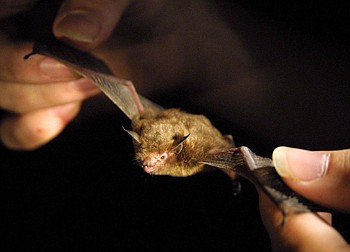Wildlife workers have found white-nose syndrome in bats from three more caves in Tennessee -- one right in the heart of Fall Creek Falls State Park.
Cherokee National Forest officials also have confirmed a migration route of bats in Cherokee Forest caves to a Smoky Mountains National Park cave where the disease was found several weeks ago.
"There are ramifications (for people and ecosystems)," said Roger Applegate, a biologist with the Tennessee Wildlife Resources Agency.
"A bat consumes astronomical numbers of insects in a night. No matter what numbers you see on some website, it could be much more than that. And they consume lots of insects that transmit human diseases. They also eat insects that damage crops and trees, and some bats act as pollinators," he said.
The discovery by staff of the Tennessee Wildlife Resources Agency and the Tennessee Department of Environment and Conservation brings the total of infected caves to six in Tennessee.
Bats from Camps Gulf Cave in Van Buren County at Fall Creek Falls, Grindstaff Cave in Carter County, and East Fork Saltpeter Cave in Fentress County have tested positive.
The syndrome first was confirmed in Tennessee in March in caves in Sullivan and Montgomery counties.
White-nose Syndrome is an infectious fungus attributed to killing over one million bats in the northeastern U.S. since it was first observed in 2006.
To date, no large bat kills have been observed in Tennessee.
Laura Lewis, a biologist with the Cherokee National Forest, said findings of the disease the the Smokies and in caves on a Virginia national forest that borders the Cherokee National Forest are especially worrisome.
"We are concerned very much for the Cherokee National Forest," she said.
Cherokee biologists have tracking equipment on some local bats, and data shows some are showing up in the cave in the Smokies where the disease has been found.
"We have found that bats in Monroe county travel to that cave in the Smokies," she said. "Bats are an extremely mobile species, and we have federally endangered Indiana bats traveling back and forth in that pattern. It's really extremely disheartening."
On the WebTo see a map of the syndrome's spread as of April, see http://tinyurl.com/28kw7qh
The disease also has been found in the George Washington and Jefferson National Forest in Virginia, which adjoins the Cherokee National Forest at it northern tip, she said.
In the Northeast, large mortalities occurred in the second and third years after initial confirmations of the fungus.
There have been no reported human illnesses attributed to white-nose syndrome, and there is no evidence to suggest it is harmful to organisms other than bats, officials have said.
Caves in Tennessee on both federal and state public lands have been closed to cavers for a year, in an effort to stem the spread of the disease.
